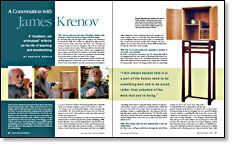A Conversation with James Krenov
A "stubborn, old enthusiast" reflects on his life of teaching and woodworking
Anatole Burkin, then executive editor of Fine Woodworking, had a conversation with renowned furniture maker James Krenov for an article in FW #162. Read the full text of the article below or become a member to download the PDF.
FWW: Tell me about your early days in Stockholm, Sweden, after deciding to make your first go at being a furniture maker.
JK: We [wife Britta and I] bought a little cottage in the suburbs of Stockholm [in 1960]. We wouldn’t be talking here right now if it hadn’t been for Britta, who knew that there was a shortage of teachers. By then we had two daughters. She took an exam and became a teacher of economics. She had studied economics in the university at Stockholm. That kept us afloat. I just struggled from piece to piece and sold them for a pittance, and maybe sometimes she would remind me that I wasn’t even paying for the electricity down in the shop, let alone my share of the cottage.
Then one or another person showed appreciation, and then the big thing happened: Craig McArt came to Sweden to study at the School of Arts in Stockholm. I met him, and he got me an invitation to come to Rochester Institute of Technology [RIT] where Wendell Castle was teaching. I taught as a guest a few months at a time.
Me, being a sort of pre-Kerouac hippie, I had a message that went with the ’70s, “Live the life that you want to live. Don’t be unhappy in your work.” And students would open their eyes and wonder who this guy was.
It was McArt who encouraged me to write a book, and I wrote A Cabinetmaker’s Notebook [reprinted by Linden Publishing, 2000]. And the first letter I got was from England from some kind of a critic who said it was going to become a classic, and that meant more to me, I think, than many other events in my life. I, a nobody, had written a book from the seat of my pants, and here’s an English critic writing me a letter saying that the book is going to become a classic. Later on I wrote the other three books more out of obligation than any thought of gain or anything like that. I wrote them because people were writing to me and saying, “You’ve told us why, now how about a little bit of the how.” So I put the other three books together.
FWW: Why do you think people have responded so favorably to your books, your message?
JK: Well, a combination of the times, the ’70s, with people radically changing their lives, and I think I will always believe that it is a part of the human need to do something well and to be proud rather than ashamed of the work that you’re doing. That’s inherent in some people. They’re not happy unless they are expressing something, unless they’re using their hands, whatever it may be—a shoemaker, a potter; a potter has wonderful hands. I think that it’s not to my credit. It’s not that I had a message that was outstanding or unique or anything like that. I just expressed the feelings that a great number of people had in the ’70s. They felt certain ways about Vietnam and work, and here was this hippie walking around talking about it was nice you could work and not be ashamed of it.
FWW: Many people credit you with inspiring them to get into woodworking.
JK: That’s true. I still get e-mail letters through the school from people I’ve never met, never seen. They write a wonderful little letter of gratitude for all that happened. “Thank you, Mr. Krenov,” or whatever it is. Lovely, it’s really heartwarming. But [in my writings] it was not a preacher talking, it wasn’t salvation or anything like that. It was just a person who enjoyed it, an enthusiast. Now I say I’m an old enthusiast. At that time I was a young enthusiast. … I was all aglow with this [feeling] that when you work well, I think it was my chiropractor who told me this, who referred to the idea of one hand clapping. I asked him what that meant, and he gave me a rather Zen Buddhist answer, and I said well, you know, sometimes when you’re working and the work is flowing, you are almost detached from what you’re doing, you’re observing yourself in work and enjoying this person whose hands are doing these things. He sort of nodded, and maybe that was the other hand clapping.
FWW: Does that still happen?
JK: I find myself completely relaxed at times. Usually I worry about my work because I have too many things in my head, but sometimes, especially with carving and a few other things, I find myself really in harmony, in kind of an Eastern harmony. I enjoy that almost more than anything else.
FWW: What sort of influence do you think your books have had on people?
JK: The sense of possibility. The sense of, “Who knows? Maybe I can do this.” We had a student last year, about age 35, with a very awkward body, which isn’t necessarily a part of the story. It was a terrific struggle for him. He made a little cabinet, and it started to turn out okay, and one day he told me, “You know, I was brought up on the fact that I couldn’t do anything right. People just told me you can’t do it, whatever it may be. You can’t do it. You can’t do it right. You can’t do it well.” Here he is starting to prove to himself, I can do it. He lit up. He was just aglow with the fact of this discovery. That he in the future was not going to be put down by that slogan, by that label. From then on, it was going to get better and better, and he would be all right. That was something I’ll always remember.
FWW: Are you sometimes surprised at how people have interpreted what you have said in your books?
JK: Oh yes, in the work itself, in the object created. They have taken something from the book, and along the way something happened, changes and things, for better, for worse, but not always for better.
They wanted to interpret it, and that’s almost a basic urge with some people. … What I really dislike are the people that will make something and say, “This is what the Shakers really meant with this chair. This is my interpretation of what the Shakers wanted to say with this chair.” I just do a backwards flip. I have to go outdoors and walk it off.
FWW: Let’s talk about inspiration and woodworking and where you find it.
JK: I think that one of the connecting elements has always been the material. I was reading about [Constantin] Brancusi the other day. He was one of the artists that really paid attention to his material whether it was wood or stone, or whatever he worked with, it meant something to him physically and emotionally.
Very often an idea by a student is connected with a memory of woods. … I’ll ask him, for example, “Do you imagine this object as light wood or dark wood or something in between?” And he’ll say, “Well, dark wood.” I’ll say, “There’s a plank of really high-quality mahogany back in the corner by the door. I want you to take a tool and go and scrape that and have a good look at it, put a little finish on it, ask yourself if that’s what you’re looking for.” Starting with a question, you can imagine it like a ghost, gray or white, or you could say you want it to look antique. Well, if you want it to look antique, you better start with dark wood. A process is something in that direction.
FWW: Your name has been associated with a style of furniture. When you hear that term, Krenovian, what does that conjure up in your mind?
JK: I really don’t know. I wish somebody would tell me. I think that people are reacting to the moderate, that is to say no radical curves, no sharp, aggressive edges. There is a friendliness about it that invites the hand. The edge is not gooey like a doughnut, but it’s friendly. You put all that together and you find the person constantly tends to make things that are hand friendly, and the use of the wood also comes out, too. This fellow [me] likes certain patterns and certain colors and is forever looking for strange wood.
FWW: Do you still enjoy the hunt for lumber?
JK: That’s incurable. Absolutely incurable.
FWW: You still go out looking?
JK: Always will be, yes. Maybe as I grow short on ideas short on energy and some other things, it will increase rather than decrease in importance. I’ll be getting energy from the wood. The work might not be so hot, but the wood will be great.
FWW: Do you see furniture making as a craft or an art, or do you not even bother making that distinction?
JK: We’re talking about a craft, of course, and I think artistic is a much, much better term than art. I don’t think that there is any need to describe it … certainly stuff in museums is going to be called art. I think that done by artistic people, it’s artistic, and it has these elements. It’s music. That’s a good description.
FWW: I’d like to talk a moment about the studio furniture movement. We’re seeing a lot of furniture showing up in galleries, where you can’t actually touch the piece. You have to stand back and observe it. Putting the piece in this environment elevates furniture to more of an intellectual experience as opposed to one that is sensual and physical. What are your thoughts on that?
JK: This is where I become a very questioning person because I and wonder in my mind where the Furniture Society is headed and what they want because they seem so self-preoccupied. They debate subjects such as “the meaning of this chair” and [ponder] the psychological, the cosmic meaning of objects. I question that in a friendly way. I don’t want to rock the boat but [such questions] will put you into orbit finally.
FWW: How do you decide whether a piece is working or not?
JK: If you read the first chapter or two of The Unknown Craftsman: A Japanese Insight into Beauty [Kodansha International, 1972] by Soetisu Yanagi, you’ll see that the main idea of his, the main philosophy is: You perceive. You do not analyze. You do not approach an object and say, “Well, I think this is the perfect triangle or rectangle or something, and this is a Greek proportion down here, and this joins them and brings them together.” You don’t. He thinks that the analytical way of judging things is anathema. … I just don’t want to know more about the thing than I can see and just react. Hey, there are five chairs here, I like this one very much. If you ask me why I like it, I probably haven’t got the right answer. I have always respected the fact that good work is timeless. That’s one of the reasons why I stay away from some of this modern creativity, knock-them-dead statements and all the stuff that’s going on.
FWW: In your search for perfection in your own work, do you ever find yourself getting impatient with the progress of a piece?
JK: Impatient, yes, yes. I have to go at 10 o’clock at night and take another look at that thing and see how it looks at a distance, and the difference between daylight and lamp light, and am I really on the right track? Is this going to work out or not? Britta had to live with that throughout, during our whole existence together. She’s been wonderful in that way.
FWW: One last question. How would you like to be remembered?
JK: Stubborn, old enthusiast.































Log in or create an account to post a comment.
Sign up Log in